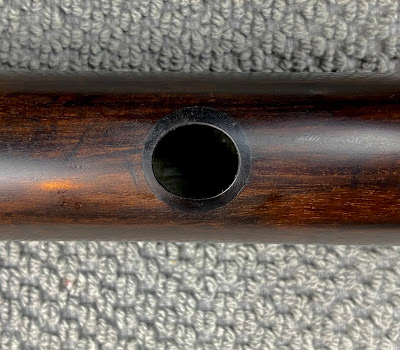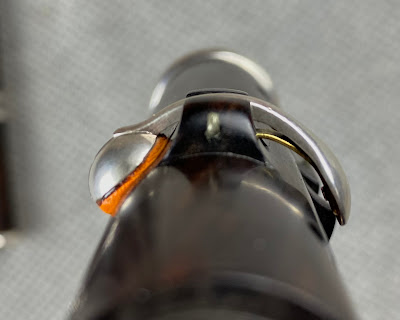As a flute player, maker and collector for some 48 years at this stage, it's sometimes remarkable how flutes come into your life, disappear from it, and very occasionally come back into it.
A bit of my personal flute history is appropriate here.
I began to take an interest in the flute in the early 70s, but that interest was stymied by a lack of flutes. I've written before about the difficulty of getting hold of any sort of a flute in Ireland in the 1970s. There were no "official" sources. If you were lucky enough, you knew a flute player who would sell you something, and of course, at that time not only was there no internet, there was almost no way for young (or old) players to acquire any knowledge about flutes. It was basically a suck it and see situation (OK, maybe blow it and see would be a better idiom)
Sometime in 1975 word reached Belfast that CCÉ headquarters in Dublin were selling flutes. Myself and Desi Wilkinson decided that we'd head to Dublin, and catch the ball on the hop as it were. I remember we asked Leslie Bingham his advice, as one of the only older flute players we knew. All I can remember at this remove is that Rudall & Rose was mentioned.
At the time, Comhaltas headquarters was in Harcourt St. in central Dublin, just to the south of St. Stephen's Green. Desi and myself got there to discover that there were about 6 or 8 flutes available. None of them were by Rudall & Rose. In retrospect, they were all German flutes, German in the Irish sense that is, what are now commonly called "nach Meyer" instruments.
Knowing nothing, or next to it, about flutes at the time, I used whatever measure of common sense I had, and picked out the flute which appeared to me to be in the best condition. It was a very standard unstamped blackwood 8 keyed (nickel silver) flute, in very playable condition.
I gave them £40 for it...and in fact all the flutes were £40, which if you think about it was a considerable amount of money at the time. I had worked on archeological digs as a summer job at the time, and our wages were £40 a week, which because it was a Dept. of the Environment job, was considered a very good weekly wage, probably the equivalent of around €800 today. Interesting that a similar flute would probably cost around half of that today.
So this was the flute that I learned to play on...and also was my introduction to flute repair and maintenance. At the time though, all I wanted was a flute that worked well enough for me to learn to play. And it did work well enough.
Untill...
About 6 months later, I moved to Cork, where there was a very vibrant traditional music scene, in which I soon became deeply involved, and it was around this time that I began to feel that I was not making as much progress as I hoped, and I also, despite the phrase - " a bad workman blames his tools" being in the back of my mind - began to think that it was the flute that was holding me back. But as explained above there were no more flutes in Cork than there were in Belfast, in fact probably less.
One of the first people I met when I came to Cork was another aspiring flute player by the name of Rob Murphy. In fact the very first night I passed in Cork city was in Rob's house, or rather his parent's house. Cork people are nothing if not hospitable. It turned out that Rob had a very nice old English 8 keyed flute that he wasn't using, and offered me a long term loan of it.
As soon as I picked it up and blew into it, I knew I had moved onto a different level. The response was so immediate, so different from the old flute. Everything seemed to fall so easily under my fingers, and it reacted so easily to changes in embouchure.
A new world.
Probably less than a year later, knowing that the flute was a loan, I had the opportunity to buy Rudall & Rose, #6315, which became my main instrument for many years, and in fact which I still have, play almost every day, and which was the pattern for my early flutes.
Rob Murphy's flute, which was an instrument by Jordan Wainwright, was returned to him, and disappeared from my life...forever... as I thought.
In 1979 I set up my workshop, and a good few years later, I came across another Jordan Wainwright, which was left in for repair. This was a very different flute, evidently much earlier, in boxwood with brass "flap" keys. The earliest date given for Wainwright is 1822, but the style of this flute was much more akin to what would be expected from the first decade of the 19th c. or even the last decade of the 18th.
So here's the flute, ( Rob's flute) a fairly standard mid to early 19th century 8 keyed English flute., stamped Wainwright London
This is not a maker you'd come across often. Here's the NLI entry, which interestingly notes only one example of a flute by him in a private collection in England.
The date of 1853 is significant here, as it is the last year that he was operating in London and in fact Jordan Wainright is probably best known for emigrating to Australia, and setting up as a flute maker there, which he did in 1853, which explains that date as the cessation of his London work.
The stamp on this flute is very faint...possibly as a result of refinishing, but against that is the fact that there appear to be no repairs, that would require that level of work. Here's the stamp on the lower middle joint.
There's no address on this stamp to aid in dating the flute
Let's have a look at the flute in more detail. Although I said it was a fairly standard 19th c. English 8 key, it was also a superior instrument with some very nice features. Cocus wood and silver, it has machine engraving on the broad rings, and a very fancy finial to the screw cork mechanism.
Unusually only some of the key slots are lined. All the slots on the foot are are lined, but on the body, only that of the short F, a combination that I've never seen before. I think the key work does display a certain degree of elegance though.
Note the way the touch declines towards the E hole, allowing the finger to side down to play the D. Movement in the other direction would involve the Long F.
In a feature that we see in some other flutes from the period, there is an ivory "liner" between the wood of the socket and the broad silver ring. The function of this is unknown, and certainly as a flute maker, I can see no particular advantage to it.
The keys are hallmarked, a feature which is much less common than imagined on English flutes. Hall marks indicate who made the item, where it was made, when it was made, the purity of the silver, and the date. Let's look at the maker's mark first...
...this is the top mark here and clearly says WT/RA
It took me a while to find this maker's mark, but here it is...
...and surprisingly, it's not the mark of a flute maker but rather that of a "flatware" maker. (scroll across) I had of course presumed that the W stood for Wainwright, but this was obviously wrong. Flatware essentially indicates a cutlery maker, but also could indicate a maker of plates etc.
The dates that the maker is registered also usefully gives us an approximate date for the flute and in fact the date mark ( third from the top )confirms this being the date letter for 1840. The marks on this flute are quite worn and hard enough to read, but I see the date letter as the gothic script E as illustrated here...
Here's another view of the hallmark
I believe that the wear that you often see on the hall marks on flute keys, is not simply a matter of over enthusiastic cleaning and polishing. Because stamping a hall mark on a narrow piece of silver like the shaft of a flute key will make it spread out, it seems obvious to me that the keys were hallmarked before the final finishing and fitting of the keys to the slots was completed, and that this, more than anything accounts for the often worn look. In order to make the expanded key fit the slot, it seems logical that often some aspects of the hallmark stamps would have to be filed away. The maker's mark on the upper key in the photo above is a good example.
This is such a different flute from the other Wainwright that I restored, that it's difficult to believe they're by the same maker, and as we'll see later it almost seems that he was consistent in his inconsistency. Regarding this flute, if there was no maker's stamp on it, I'd be very inclined to say it was by the younger Prowse.
Research showed that quite a lot is known of Wainwright in Australia. The Powerhouse Museum in Castle Hill, NSW has one of his flutes, and their site holds quite a lot of information about him. See here This flute is a very standard 4 keyed flute of the type that is in many ways anachronistic in the period it was made, being more typical of a flute from the late 18th century. What is potentially interesting about it is the surmise that it is potentially made from an Australian hardwood instead of cocus.
The following is from their site.
"He is known to have travelled to Sydney with his wife in 1853 and by 1857 had established himself in George Street, Sydney where he worked in several premises until 1883. He died in Newtown in 1884 at the age of 86. Apart from being recorded as a musical instrument maker at various times he is also recorded in Sydney trade directories as a wood turner, suggesting he certainly had the skills to produce quality work rather than merely importing instruments and stamping them with his mark......
.......The reasons surrounding Wainwright's decision to leave London are also unclear. Whether it was the pull of a new land with new resources and the prospect of prosperity from the gold discoveries or the push of an increasingly competitive market in London is uncertain. Clearly when in London Wainwright would have seen several new developments in flute design and equally would have missed seeing many others after he left. This possibly explains why he went to Australia but continued manufacturing flutes in an older style, still using a simple fingering system. This dislocation from the English musical instrument making scene possibly suggests that Wainwright could not compete with other makers and the amount of innovation occurring in London. However, although Wainwright adhered to this older style of general design he adopted the use of new materials in Australia. This included the use of a native timber, Myall (Acacia pendula) and silver from Moruya on the New South Wales south coast. It is unclear at this stage how many of his Australian flutes were made using Australian materials but an instrument comprising them was used as his showpiece instrument for the exhibitions mentioned above."
For me, the above reveals some interesting conundrums.
The NLI, even the most recent edition (1993) indicates that only one flute by Wainwright is known, but the Australian site seem to indicate that many more are extant.
"Wainwright exhibited in several colonial and international exhibitions such as the 1866 Intercolonial Exhibition of Australasia in Melbourne, a preliminary Sydney exhibition to the London International exhibition held in 1861, the London International Exhibition in 1862 itself and the Paris International Exhibition in 1867. Several of his instruments both during his London period and in Australia are stamped "Patent" however, there appears to be no record of such a patent existing in either English or Australian records."
and also...
"The quantity of flutes by Wainwright in Australia is unknown. However, four instruments have been sighted with his Sydney mark although it is assumed more examples exist seeing he is listed as an instrument maker in Sydney for almost thirty years. Each of these existing instruments are different in type from the others and apart from this four key instrument in F include an eight key, a single key in B flat and a single key in F. There is also a reference to a sighting of a clarinet with Wainwright's Sydney mark. This variety of flutes is consistent with surviving examples of his London work although materials differ. These include an eight key boxwood flute, an eight key cocus flute, an eight key ivory flute, a six key boxwood flute, a single key boxwood flute in A and a piccolo."
I hope I'm reading the text above correctly in that the last flutes are from his London output? I'm in contact with the Powerhouse Collection, and I'm hoping to hear from them about the sources for their research.
So, to finish...
How did the flute, that I gave back to Rob Murphy in 1978(ish) end up back in my hands.....
Rob Murphy who was a medical student when I first met him, qualified as a doctor, and in time went to work in Newfoundland.
He was playing the flute a lot at that stage, and fell in with the vibrant trad scene in St. John's, where he met a young flute player called Michelle Brophy. Michelle Brophy bought a flute from me in 1996, and by a series of coincidences I came to know her and her husband, piper Rob Brown very well and ended up teaching Michelle flute making over a period of years. (I'm happy to report that she's now making excellent flutes) Rob Murphy eventually came back to Ireland, where he worked as a GP in Cavan, and despite meeting him once a good few years ago, we lost touch. On the occasion that we met...it was at some musical event in Dublin... the Wainwright did come up in conversation. He said it had been sadly neglected, I offered to do it up in return for the original loan, but nothing ever came of it.
Michelle didn't loose contact though. She credited him with her development as a flute player and kept in contact over the years.
Earlier this year, knowing that Michelle was making a visit to Ireland I was able to make contact with Rob again, and for the second time he was extremely generous, giving me the flute again...for good this time.
And so after Michelle first visited Rob in Cavan, the circle was complete, and Michelle delivered the flute to me...
...and it's just as good as I remembered.
Very special thanks to the Powerhouse Collection for permission to quote their research, especially to Dr. Michael Lea for his extensive research on Wainwright and to Kathy Hackett for her help in preparing this post.



















































